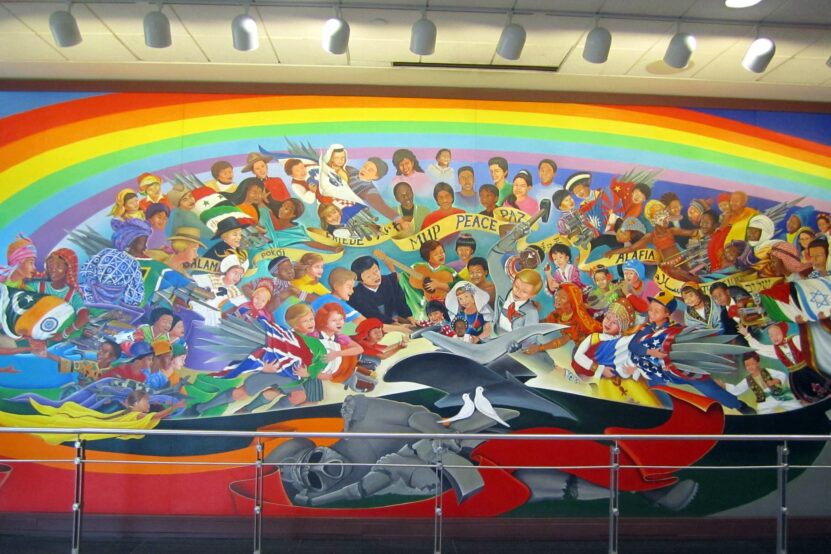From its inception, Denver International Airport (DIA) has been a magnet for conspiracy theories. The airport’s vast size, unusual design, and mysterious underground tunnels have inspired countless tales of intrigue and secrecy. Perhaps no aspect of DIA has captured the public’s imagination quite like its collection of murals, which have been the subject of numerous conspiracy theories since their unveiling in 1995.
In this comprehensive article, we will delve into the history, symbolism, and controversy surrounding the Denver Airport murals. We will explore the intentions of the artists who created them, as well as the various conspiracy theories that have emerged over the years. Our goal is to provide an engaging, informative, and accessible analysis of these enigmatic works of art and to separate fact from fiction in the process.
The Denver Airport Murals: Background and Context
1. The Artists Behind the Murals
The murals at Denver International Airport were created by two internationally recognized artists: Leo Tanguma and Gary Sweeney. Tanguma, a Mexican-American artist, is known for his large-scale murals that often address social and political themes. His work can be found in various public spaces throughout the United States and Mexico. Sweeney, on the other hand, is a contemporary American artist whose work often incorporates humor, text, and everyday objects to create thought-provoking installations.
2. The Commissioning Process
The murals were commissioned as part of the airport’s public art program, which aimed to enhance the airport’s design and cultural significance. The artists were selected through a rigorous process that included input from local and national art experts, as well as members of the Denver community.
3. The Murals’ Themes and Symbolism
1. “In Peace and Harmony with Nature” and “The Children of the World Dream of Peace” by Leo Tanguma
Tanguma’s two murals, “In Peace and Harmony with Nature” and “The Children of the World Dream of Peace,” are a visual exploration of the environmental and human challenges faced by society. The first mural, “In Peace and Harmony with Nature,” depicts the destruction of the environment and the suffering of both humans and animals. The second mural, “The Children of the World Dream of Peace,” offers a vision of hope, showing children from around the world coming together to rebuild and protect the planet.
2. “America, Why I Love Her” by Gary Sweeney
Sweeney’s “America, Why I Love Her” is a tongue-in-cheek homage to the United States, featuring a series of images and phrases that celebrate various aspects of American culture. The work is meant to be both humorous and thought-provoking, inviting viewers to consider their own relationship to American identity and values.
The Conspiracy Theories
1. Origins and Early Theories
Conspiracy theories about the Denver Airport murals began circulating almost immediately after their installation. The airport’s remote location, massive size, and reports of underground tunnels fueled speculation about covert government activities. These suspicions were further stoked by the murals’ enigmatic imagery, which some interpreted as containing hidden messages or allusions to secret societies.
2. The New World Order Theory
One of the most enduring conspiracy theories about the murals is that they contain hidden messages related to the New World Order, a purported global elite seeking to establish a one-world government. This theory is based largely on interpretations of Tanguma’s murals, which some believe depict scenes of global catastrophe and control.
3. The Freemason Connection
Another popular theory surrounding the murals is that they contain hidden symbols and messages related to the Freemasons, a secretive fraternal organization with a long history of alleged involvement in political and social intrigue. This theory is fueled in part by the presence of a time capsule placed beneath a capstone in the airport, which bears the symbol of the Freemasons and is inscribed with the phrase “New World Airport Commission.” However, it’s worth noting that the Freemasons are a philanthropic organization, and their involvement in the construction of public buildings is not uncommon.
4. The Apocalypse and Doomsday Bunker Theories
Some conspiracy theorists argue that the murals depict an apocalyptic event, such as nuclear war, a global pandemic, or catastrophic climate change, and that they serve as a warning of an impending doomsday scenario. This theory is often tied to claims that the airport’s underground tunnels and facilities are part of a secret doomsday bunker built to house the global elite in the event of a cataclysmic event.
Debunking the Conspiracy Theories
1. The Artists’ Intentions
Both Tanguma and Sweeney have spoken publicly about their intentions and the meanings behind their murals. Tanguma has stated that his murals are intended to convey a message of hope and the possibility of a brighter future for humanity, while Sweeney’s work is meant to provoke thought and discussion about American culture. There is no evidence to suggest that either artist had any ulterior motives or connections to secret societies when creating their works.
2. The New World Order and Freemason Theories
While the murals may contain imagery that can be interpreted as representing global catastrophe and control, there is no concrete evidence linking them to the New World Order or Freemasonry. The themes present in Tanguma’s murals are consistent with his broader body of work, which often addresses social and environmental issues. Similarly, the presence of a Freemason symbol on a capstone at the airport is not unusual, as the organization frequently participates in the construction of public buildings.
3. The Apocalypse and Doomsday Bunker Theories
The apocalyptic and doomsday bunker theories surrounding the murals are largely based on speculation and the misinterpretation of their content. While Tanguma’s murals do depict scenes of environmental destruction and suffering, they also convey a message of hope and renewal as children from around the world come together to rebuild the planet. Furthermore, claims about the airport’s underground tunnels and facilities being part of a secret doomsday bunker have been debunked by numerous investigations, which have found that the tunnels primarily serve as a utility and transportation network for the airport.
Final Words
The Denver Airport murals, like any thought-provoking work of art, are open to interpretation and have inspired a wide range of reactions from viewers. While the conspiracy theories surrounding the murals can be intriguing and entertaining, they ultimately detract from the true meaning and significance of these powerful and engaging works.
By delving into the history, context, and intentions of the artists who created the murals, we can gain a deeper appreciation for their beauty, symbolism, and relevance to contemporary issues. By doing so, we can separate fact from fiction and appreciate the murals for what they truly are: captivating public art that challenges and inspires viewers to reflect on the state of our world and our collective responsibility to create a better future.

